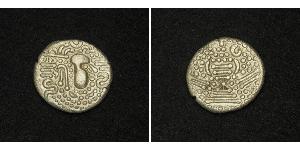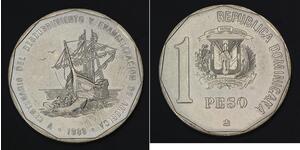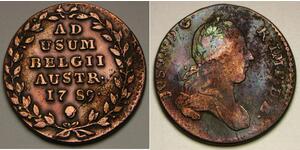(Vendue pour $206.0)
Denomination: Dirham
Mint Year: 1258 (656 H)
Reference: Album 1223.2.
Mint Place: Tiflis (Georgia)
Ruler: Mögke Khan (1251-1260 AD / 649-658 H)
Condition: Removed from jewellery (welding mark at 3 o'clock), otherwise VF
Diameter: 21mm
Material: Silver
Weight: 2.58gm
Obverse: Inscription in three lines with Tamgha in the middle. All within square border.
Reverse: Inscription in three lines with Tamgha in the middle. All within square border.
Khagan or Kahn Khan or Qagan ( Mongolian: хаан, Khaan, Mongolian Script: ᠬᠠᠭᠠᠨ, Qaγan; Chinese: 可汗; pinyin: Kè hán or Chinese: 大汗; pinyin: Dà hán; Persian: خاقان, Khāqān), is a title of imperial rank in the Mongolian and Turkic languages equal to the status of emperor and someone who rules a khaganate (empire). The words "khagan" and "khan" are distinct today, though historically they were the same.
em>.
Möngke Khan (Mongolian: Мөнх хаан), born Möngke, or Mengu in some sources, (January 10, 1209 – August 11, 1259 ), was the fourth Great Khan of the Mongol Empire from July 1, 1251 – August 11, 1259. He was the first Great Khan from the Toluid line, and made significant reforms to improve the administration of the Empire during his reign. Under Möngke, the Mongols conquered Iraq and Syria as well as the kingdom of Nanzhao. He was given the Chinese-style temple name Emperor Xianzong of Yuan (traditional Chinese: 元憲宗; simplified Chinese: 元宪宗; pinyin: Yuán Xiànzōng; Wade–Giles: Hsien-Tsung) by his successor Kublai Khan, who founded the Yuan Dynasty.
The Mongol Empire (Mongol-yn Ezent Güren; Cyrillic: Монголын эзэнт гүрэн, in Russian chronicles also Horde - Russian: Орда) existed during the 13th and 14th centuries, and was the largest contiguous land empire in human history. Beginning in the Central Asian steppes, it eventually stretched from Eastern Europe to the Sea of Japan, covering large parts of Siberia in the north and extending southward into Southeast Asia, the Indian subcontinent, the Iranian plateau, and the Middle East.
The Mongol Empire emerged from the unification of Mongol and Turkic tribes of historical Mongolia under the leadership of Genghis Khan. Genghis Khan was proclaimed ruler of all Mongols in 1206. The empire grew rapidly under his rule and then under the rule of his descendants, who sent invasions in every direction. The vast transcontinental empire which connected the east with the west with an enforced Pax Mongolica allowed trade, technologies, commodities and ideologies to be disseminated and exchanged across Eurasia.
The empire began to split as a result of wars over succession, as the grandchildren of Genghis Khan disputed whether the royal line should follow from Genghis's son and initial heir Ögedei, or one of his other sons such as Tolui, Chagatai, or Jochi. The Toluids prevailed after a bloody purge of Ögedeid and Chagataid factions, but disputes continued even among the descendants of Tolui. After Möngke Khan died, rival kurultai councils would simultaneously elect different successors, the brothers Ariq Böke and Kublai, who then not only had to defy each other, but also deal with challenges from descendants of other of Genghis's sons. Kublai successfully took power, but civil war ensued, as Kublai sought, unsuccessfully, to regain control of the Chagatayid and Ögedeid families.
The Battle of Ain Jalut in 1260 marked the high-water point of Mongol conquests, and was the first time a Mongol advance had ever been beaten back in direct combat on the battlefield. Though the Mongols launched many more invasions into Levant, briefly occupying it and raiding as far as Gaza after a decisive victory at the Battle of Wadi al-Khazandar in 1299, they withdrew due to various geopolitical factors.
By the time of Kublai's death in 1294, the Mongol Empire had fractured into four separate khanates or empires, each pursuing its own separate interests and objectives: the Golden Horde khanate in the northwest, the Chagatai Khanate in the west, the Ilkhanate in the southwest, and the Yuan Dynasty based in modern-day Beijing. In 1304, the three western khanates briefly accepted the nominal suzerainty of the Yuan Dynasty, but when it was overthrown by the Han Chinese Ming Dynasty in 1368, the Mongol Empire finally dissolved.
1 Peso République dominicaine Cuivre/Nickel
Le groupe a 3 pièces / 3 prix
⇑
2 Liard Austrian Netherlands (1713-1795) Cuivre
Le groupe a 4 pièces / 4 prix
⇑


















-300-150-N7QKX9ISGfEAAAFX9awaL_VH.jpg)






